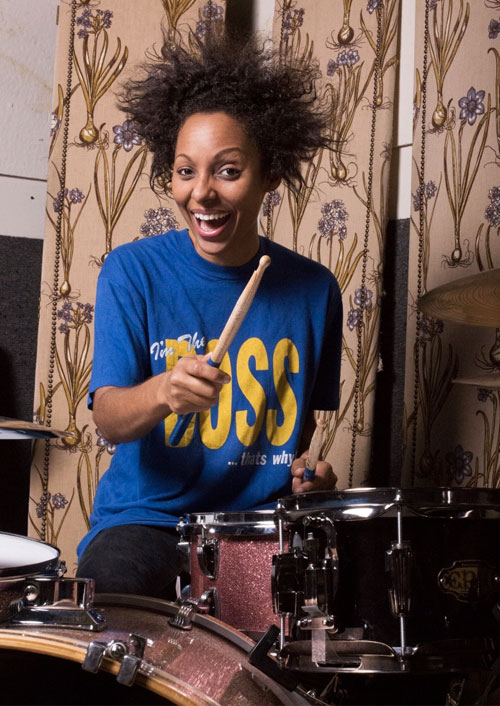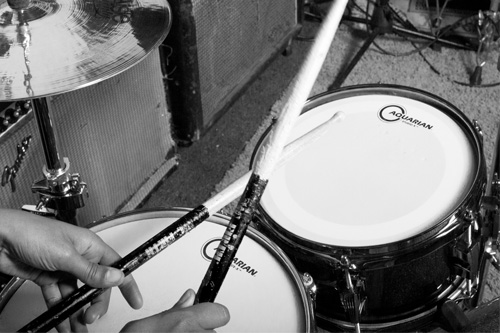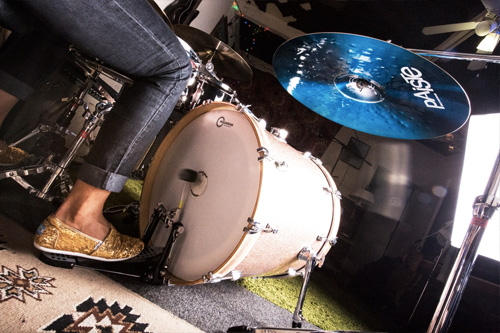While Kate Nash continues writing and demoing for her upcoming album, Alicia Warrington, her drummer, is working on two other projects. She plays drums and occasionally bass for The Bulls, an indie-pop band featuring Anna Bulbrook from The Airborne Toxic Event and Marc Sallis from The Duke Spirit.
“They’re working with me and with Amy Wood, who plays drums with Fiona Apple and a few other bands,” she says. “It’s back and forth between the two of us. We’ve both recorded and done live shows. They’re a continual band, and I come and go as time permits.”
She is also working on her solo debut album as DOHRN, which she describes as a “one-woman extreme-metal” project, with four of the six songs recorded for an upcoming EP, End of Days. To date, she has released two singles/videos, “Becoming The Disease” and “Levels Of Hate.” Recording the EP at home, Warrington handles vocals, plays guitar and bass, and programs drums in Logic Pro.
Optimized for Performance
Over the years, Warrington’s criterion has not changed in her search for optimal equipment. “The first thing I look for is gear that I can use for rock, pop, metal, R&B, whatever. I need to have the right tools,” she says. “It’s taken me 25 years to figure out what my sound is, and that’s OK. It’s like figuring out who you are as a person. That takes a while. Each year, each friendship, each relationship, you learn something different about yourself. It’s the same with gear. Each gig, every new band, you learn something different about your needs, your wants, your style, what’s working and not working, how you can change it and make improvements. I choose gear that’s going to work across the board. Instead of always having to add more things to my kit, I pick the things that are going to work in every situation right off the bat.”
It’s taken me 25 years to figure out what my sound is, and that’s OK. It’s like figuring out who you are as a person. That takes a while."
Growing up in Saginaw, Michigan, Alicia Warrington’s childhood was filled with music. Her mother introduced her to R&B, her grandparents listened to polka music, her sister and uncle brought home rock and metal albums, and she discovered punk on her own. Warrington absorbed it all and held on to her early influences, which have served her well enough to record and perform with a range of artists, from En Vogue’s Dawn Robinson to Miley Cyrus, Tracy Chapman, Selena Gomez, Chris Rene, Gore Gore Girls, Kelly Osbourne and Kate Nash.

Alicia Warrington
Warrington plays guitar and bass, and took guitar lessons for four years, but drums are her primary instrument. She taught herself to play on her uncle’s 16-piece Ludwig kit when she was 11 years old. She tried other brands but quickly returned and has remained loyal to Ludwig for her studio and touring needs. She uses a Classic Maple kit with a 22-inch kick, 12-inch tom, 18-inch floor tom, and 13-inch snare.
“I’ve had this kit for probably ten years,” she says. “It’s a reliable touring machine. It sounds great in any room. The shells are 7-ply maple. The kick is punchy, focused, and loud. It sounds as great in recording as it does in live situations. I recently added K-Brakes to my setup. It’s a little anchoring system to hold your kick drum in place, with super-sturdy plates that attach to the tip of your kick legs. I have a pretty powerful kick, but the drum hasn’t moved or slipped away since adding these to my kit. They’re a necessity for me on tour.”
Adaptability
In order to move from one genre to the next for session work, and for power and consistency on the road, Warrington swears by Aquarian drumheads. “They’ve been in and out of my life throughout my playing and I kept coming back to them, just like Ludwig,” she says. “I signed with them in 2008. I want something that works, lasts, and sounds great. I fell in love with the Aquarian sound and how great they are at tuning, or not having to tune them as much. I can practice, leave my rehearsal place, come back a couple of days later, and they’re still in perfect tune. Obviously, when the venue changes every day on tour, you want a head that’s easy to tune in different rooms, and that’s where Aquarian is on top of the game.”

Alicia uses Aquarian drumheads and Vic Firth American Classic Rock sticks
In the studio she uses the clear Super-Kick II (double 7mm ply) on her kick and the Texture-Coated Response 2 (double 7mm ply) on her toms. “They’re good for the studio because they can be tuned tight or low,” she says. “They have a full sound, and as the name says, they respond to the stick and to the room. The Super-Kick II has a focused sound and mics well in the studio.”
“On tour I play differently than in the studio or in a practice setting. There’s more energy and intensity. You’re feeding off your band members and the crowd and there’s such an adrenaline rush. I hit a little harder, I’m more likely to break things, so I use the Force Ten (double 10mm ply), a newer head, for my toms. They have more attack and depth, and I change the heads less frequently because of their durability. For the kick I use either a Hi-Impact or a Super-Kick 10. If I’m playing R&B or hip-hop, I use a Ludwig Epic 10x6 side snare with an Aquarian Texture-Coated Studio-X head. On my main snare I use the coated Hi-Velocity head. I use it on recordings and on tour because of the control. It has great dynamic ability for the studio, yet it carries through in a live situation because it is a powerful head. It can take a beating live, or it can give you the subtle nuances that you need in the studio.”
She began using Vic Firth sticks 20 years ago and officially became one of their artists in 2002. She uses the American Classic Rock sticks for their dense sound and cymbal responses and the Gavin Harrison signature sticks for their length. “That’s my main model, because at almost 17 inches, it’s the longest stick I’ve found,” she says. “It’s powerful but very well balanced and has great dynamic capabilities. It has the Vic Grip at the end so that your sticks don’t slip, which makes them easier to play with when it gets hot and sweaty onstage. I like the extra-long sticks, because when I’m in my zone and into the music, I don’t have to look every time I’m going to hit a cymbal, if it’s off to the right side. I know where it is and I know that this stick is going to hit it.”
Warrington joined the Paiste roster in 2012. “That was one of the best gear switches I ever made,” she says. “A Paiste cymbal is like none other. They have the best sound, they’re a classy company, and they make a product that is far above the rest.” She uses 14-inch hi-hats and a 22-inch ride from the Twenty Custom Collection, an 18-inch Alpha Swiss thin crash, 18-inch or 19-inch Signature Series full crash, a 20-inch 2002 Series crash, and sometimes a 22-inch Stewart Copeland Signature Blue Bell ride.

Alicia joined the Paiste cymbals roster in 2012
“The Alpha thin crash is like a China, but not as abrasive or as loud,” she says. “It cuts through when necessary, but dies out instead of taking over the whole sound. The 19-inch Signature full crash has a soft to medium tone. It blends nicely at that volume, so it works across the board with different music styles. The Signature Series sounds like you’re sprinkling a handful of warm glitter. It’s bright, yet warm, and mixes well with other sounds. The 20-inch 2002 crash is medium to loud in volume. It’s like a classic rock crash and ‘plays well with others,’ I like to say. The Twenty is brighter than the Blue Bell, so I switch back and forth, depending on the gig. If I’m playing with Kate Nash, I use the Twenty Custom ride because you can crash it and it has a bit less of the bell sound.”
When she joined Kate Nash’s band, Warrington added a Roland SPD-SX Sampling Pad to her kit. Her introduction to the product line began during her first run with Kelly Osbourne, from 2002 through 2005, which was also her first professional gig after moving to Los Angeles. (She worked with Osbourne again in 2009.) In 2005, Osbourne’s music went from rock to electronic dance-pop, and the band shifted from two guitars, bass, and drums to two keyboard players and drums. Warrington toured with a Roland TD 20 and went back to Roland with Nash.
“Kate’s old drummer was using Roland, so it came into my world again about a year and a half ago,” she says. “Kate has a full band, but there are a few bells and whistles that I need to trigger from time to time with some of her older songs. For example, “Pumpkin Soup” was one of her big singles, and there are horns in it, so I trigger that on the Roland pad.”
Tour Prep
When Warrington is preparing for a tour, she rehearses daily, putting in several hours each time. When she’s not on the road, she keeps her drums set up at a friend’s recording studio and practices several times a week, both to keep her chops up and as a form of therapy. Her routine is the same as when she taught herself to play.
You’re just into your drums and the music in your head. It’s very meditative. Playing drums is my meditation time."
“I listened to tapes and played along with the bands,” she says. “Now I put on my iPod shuffle and play along with whatever pops up. My iPod goes from Miranda Lambert to Suffocation to En Vogue. It doesn’t have to be a song I know or that I sat down at the kit with before. I put my own beats and grooves on top of the music sometimes, too, just to keep my skill levels up. I go until I don’t want to play anymore, and that can be hours, especially when you get into that space where you’re not thinking about anything else. You’re just into your drums and the music in your head. It’s very meditative. Playing drums is my meditation time."
Drums & Percussion